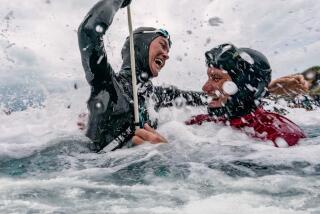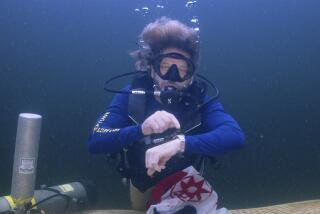WET & WILD : Plumbing Depths of Experience
- Share via
Eric Hanauer may be the most accomplished uncertified diver in the history of the sport. He has published hundreds of articles, written two books on the subject, explored most of the world’s submarine wonders with his camera and instructed thousands in the art and science of underwater exploration.
Yet a close look at his credentials will reveal the conspicuous absence of the basic open-water certification, now required by dive shops (for air) and dive boats (for rides).
“I took my pool class in Chicago in the winter,” Hanauer explained, “and nobody dives in Chicago in the winter.”
As a result, his checkout dive--the final test to pass to be certified by a recognized instructor--was postponed until spring, when the lakes would thaw. But by then, Hanauer said, his dive instructor had had a “brush with the law” and was no longer in business. So the young man with the pool class under his belt simply took the next logical step; he got certified as an instructor himself.
“Such things weren’t so unusual in those days,” said Hanauer, now 58 and a diver since 1959.
He certainly didn’t let a little thing like the lack of a proper certification get in the way of an illustrious career, however.
After moving to California in 1964, Hanauer earned a master’s degree in physical education from UCLA and ended up teaching swimming and scuba at Cal State Fullerton, where he is still on the staff.
It wasn’t until the mid-1970s, though, that the Costa Mesa resident began producing the kinds of materials that earned him a spot in the most recent edition of the Who’s Who in Scuba Diving, a nationally distributed book published annually by the Academy of Marine Sciences and Undersea Research.
He started by writing an article for Skin Diver magazine in 1977 about a mysterious airplane wreck that had been found in the waters off Laguna Beach. Since then, Hanauer said, he has written more than 250 articles for Skin Diver and practically every other major dive magazine published in the world. Today, he averages about 25 new pieces a year for such publications as Discover Diving, Scuba Times, Underwater USA and Ocean Realm.
It was the magazine writing that led to the publication of his first book--”The Egyptian Red Sea: a Diver’s Guide”--in 1989. Hailed as the definitive work on diving in the Red Sea, the book--illustrated by 150 of Hanauer’s own underwater photographs--resulted from five years’ diving in the area.
“I just fell in love with the place,” the author said. “The book filled a need.”
Other diving adventures have taken him to Baja, Tonga, Galapagos, Maldives, New Zealand, Yap, Palau, Rota, Guam, Borneo, the Bahamas, the Marshall Islands, the Caymans, Jamaica and Florida.
Next January, Hanauer expects to publish his second book, “Diving Pioneers,” interviews with people who helped start sport diving in America. Now in their 60s, 70s and 80s, many of these early divers are Southern Californians with colorful stories to tell.
“Southern California was kind of the incubator of diving,” Hanauer said. “We’ve had a tremendous influx of new divers in the last eight or 10 years. Their interests lie in the current gear and current hot destinations and they really don’t know where we came from. I think people will come away from this book with an appreciation for diving’s past.”
Hanauer himself, of course, is part of that past. It was a quaint and innocent time when divers experimented, constructed their own gear, pushed themselves to the limits and took chances that today would be unthinkable.
Now things are safer, more scientific, more regulated, more controlled.
Yet diving still retains a romance that keeps people shuffling toward the water in their fins.
“It’s being able to push beyond the limits and interact with a world that other people can only imagine,” said the man who has logged 3,000 dives and certified 2,000 divers since 1973. “It’s the feeling of being underwater, of weightlessness, of being able to move in three dimensions. Even on a day when the visibility is poor and the surge is rough and the water is cold, I can slip under the surface and feel like I’m at home.”
More to Read
Sign up for Essential California
The most important California stories and recommendations in your inbox every morning.
You may occasionally receive promotional content from the Los Angeles Times.













